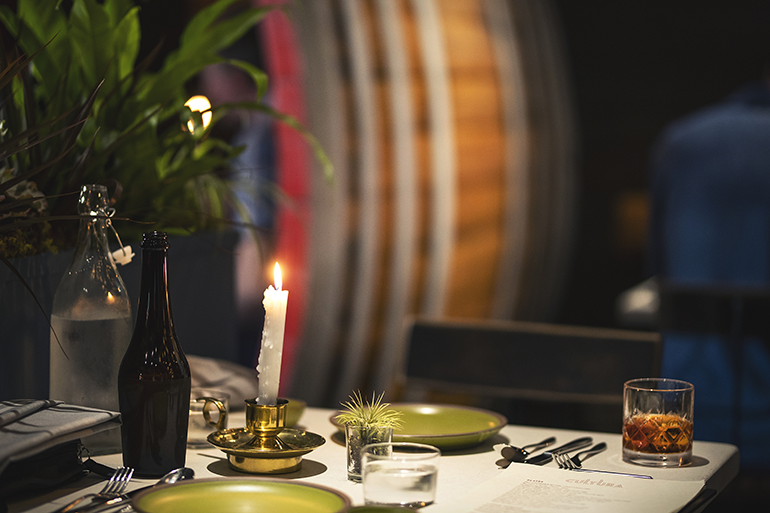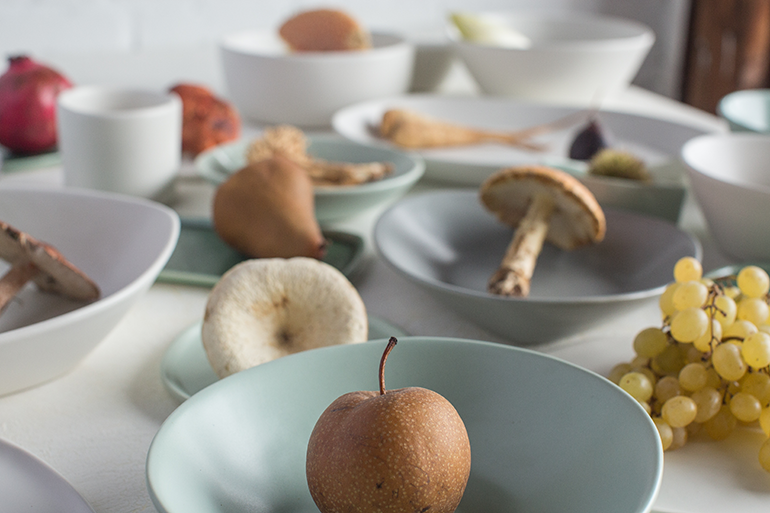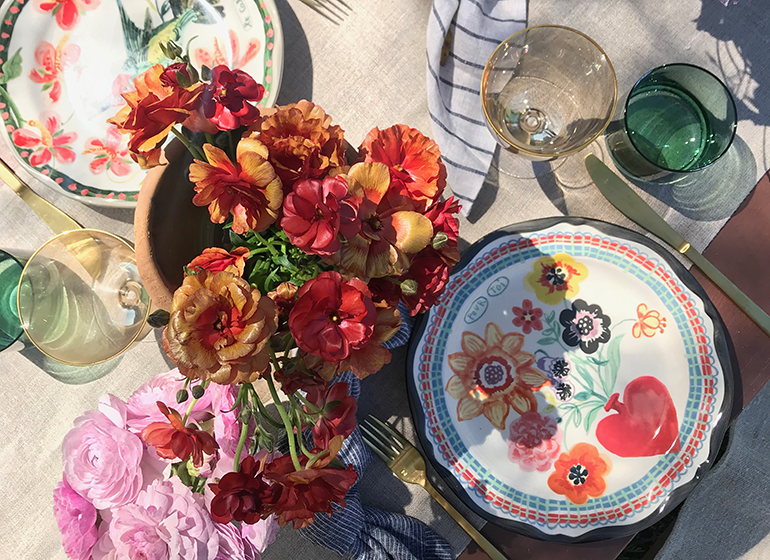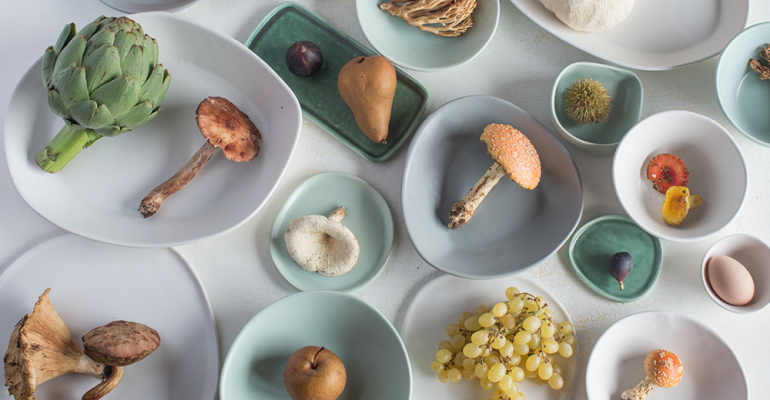Objects on the table tell a story without saying a word. Just like the ingredients of the menu, tablescapes can be curated and can telegraph visceral vibes of dining emotions, running the gamut from intimacy or celebration, to theatrics and whimsy.
When it comes to table design, tablecloths, plastic flowers or plants that block the view of guests, mason jars, charcuterie on cutting boards and anything served in fry basket or other cutsie holders are out, design experts say.
What’s in? Fresh flowers, antique candelabras, rustic and bespoke tableware — and curated items that communicate a mood or theme. (Click here to see a slideshow of what is on or off the table.)
Here’s a look at different approaches to table design.

Tall candles in antique candle holders set the tone to “intimate” at Cultura, a new restaurant in Asheville, NC.
The bacchanal: over-the-top clutter and abundance
Special dining experiences called Bacchanal Feasts are a calling card of Cultura, a new concept in Asheville, N.C., from chef Jacob Sessoms (also of Table, All Day Darling and The Imperial Life) and Wicked Weed Brewing’s co-founder, Walt Dickinson. Shareable small plates are available a la carte, but the Bacchanal Feasts — and also variations like “The Grand Bacchanal” and “Dine Like a Chef” — are a carefully choreographed selection of dishes meant to be enjoyed communally in large-format, family-style meals.
Crafting each memorable experience relies heavily on how the table looks and functions. This is where on-trend tablescapes come into play, and at Cultura, the intended atmosphere is farmhall-meets-European beer house.
The table takes on a different whimsical look/vibe for experiences like, for example, The Swiss Chalet (fondue in a bread bowl); Bucket of Birds (smoked and fried chicken and quail); The Country Club (steak and lobster on a fancy silver platter); Racks on Racks on Racks (baby back ribs on wood) and the Charleston No. Six, billed as “all the crabs and golden rice.”
Cultura’s austere white tables provide the perfect “blank canvas for the food to really shine,” said Elizabeth Bates, art director of Wicked Weed. The fundamental blankness of each table is flooded with color and creativity when the magic (meal) happens, she said. “It was important for us to bring some color and detail that would make it more unique.”
It’s a balancing act between a table that “tells a story of abundance and encourages our diners’ appreciation of what we are providing” and having too much clutter on a table, Bates has found. Straddling that line with aplomb, elements of Cultura’s meals are served on rustic, simple ceramic (from local shop East Fork Pottery) and wooden platters and the large format dining experiences feature lots of antique sterling silver and serviceware.
The colorful, geometrically printed “short list” of beer, wine and cocktails is presented as “the first hint at what is to come for your meal,” Bates said. In the first moments of dinner, “it’s the only color on the table and I wanted to create something that reflected the elegance behind the restaurant.”
Candles are also a powerful piece of the tablescape puzzle at Georgetown, a stylish American-contemporary restaurant in Lakewood, Ohio, that favors bright, crisp white napkins on bare tabletops, heavy silverware, white china and sleek glassware. The candlesticks are in color, and “a money saver that adds bright tones to a tablescape without full floral arrangements,” said Laurie Sanders, general manager at Georgetown.
In the summer months, Sanders has been obsessed with bright, cheery yellow, and as the fall months deepen, so will the candles.
“The colder months in Cleveland call for more candles,” Sanders said. “The warm glow in the room feels romantic and cozy.”
Cozy all-day dining concept Cesarina, in San Diego’s burgeoning Point Loma neighborhood, is inspired by the vibrant colors of a classic Italian trattoria, accomplished through hand-painted plateware in hues from bright blue to soft lavender. Italian-inflected, California-forward entrees like beet carpaccio and Melone, Bufala & Prosciutto really pop with these colors.
Rustic handmade porcelain pottery is the specialty of 15 employees at Haand in downtown Burlington, N.C. Each piece coming out of the shop is unique, and Haand works with restaurants to help nail the perfect aesthetic for every table, often producing custom shapes for special menu items.

North Carolina handmade ceramics shop Haand works with restaurants to choose the best shapes and colors for each concept, often in nature-inspired colors from soft to bold.
Rustic: The look of local simplicity
“A concept or type of service — family style or small plate, etc. — will really influence the tableware selection,” said Mark Warren, co-founder of Haand. “This can lead to some really fun options of plates that the chef will have on hand when they are thinking of next season or next week’s menu.”
Local, handmade tableware should get just as many props as the greens from the local farmer, Warren posited. “Our customers who have a local farm-to-table concept find a lot of synergy with us since we’re made in the USA in small batches,” he said. “A menu will often say where the chef sources the vegetables and meat. With us, they can name the city and company where they source their tableware.”
Trends Warren has seen restaurateurs starting to seek out more include smaller main-dish plates, mixed patterns and colors and matte finishes.
“Lots of tiny bowls and small plates are really popular, too, depending on the restaurant’s vibe and concept,” Warren said. “We have a few color options that are really bold: a pink, an orange, a robin’s egg blue … We’ve had more and more restaurants choose these bright, fun colors and they look great. Clean, simple, solid colors are always in vogue and are a great part of modern/contemporary décor.”

San Diego and Orange County-based Urban Kitchen Group has created a signature look for its three restaurants with its dinnerware, which is available for guests to purchase at in-house gift shops.
Dine, then buy
Another way for restaurant operators to capitalize on their tablescape is through merchandising.
San Diego and Orange County-based Urban Kitchen group and Urban Kitchen Catering, owned by Tracy Borkum, infuses an eclectic mix of timeless and on-trend with tablescapes throughout three restaurant concepts: Cucina Urbana, Cucina Enoteca and Cucina Sorella. Borkum considers the role of design through the lens of guest experience, and extends the offer to guests wanting to create that experience at home.
The same dinnerware used on the tables is available at in-house wine/gift shops integrated into each restaurant. Through this multi-tiered approach, Borkum has successfully established a recognizable aesthetic for the restaurant group as a whole. The look is colorful/whimsy, with flowers, butterflies and handwritten French words on plates; fresh flowers in eye-popping colors reflect on pastel-toned glass. Customers are reportedly looking for “the Cucina look” specifically, a triumph in branding through tablescapes.
Contact Tara at [email protected].
Follow her on Twitter @Tara_Fitzie.





